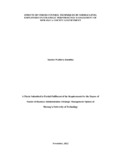| dc.description.abstract | Globally, employees experience stress at the workplace. It has become a real exertion in most organizations especially in the developing countries where the significance amount of stress at the workplace has had influence on employees’ strategic performance. Organizations need employees to get the job done because employee’s strategic performance is important to the success of the organization. Stress control techniques are designed to help employees reduce stress at the workplace. The impact of stress on the employee performance has a direct impact on the implementation of organizational strategies. Despite having stress control techniques in the organizations, research studies show that stress at the workplace has not been controlled effectively, thus affecting employee strategic performance management. Increased stress levels have led to reduced work performance and subsequently the strategic goals and objectives of the organization are not met. Thus, the study sought to address the issues that cause stress at the workplace and their influencing factors and therefore focused on job design, training, employee welfare programs and incentives as the key stress control techniques. The general objective is to establish the effect of stress control techniques by middle level employees on strategic performance management of Murang’a County Government. The research study adopted descriptive survey which is the method of research which concerns itself with the present phenomena in terms of conditions, practices, beliefs, processes, relationships, or trends. The study was confined to Murang’a county government in Murang’a County. This is where the strategic decisions and the central planning of Murang’a County are operated.The middle-level employees of Murang’a County Government were the target population, which they comprised of 4,254 respondents. Stratified random sampling was used as the most appropriate sampling technique, since the population is not a homogeneous group. Systematic sampling was used in each group to come up with the respondents which involves selecting the samples at regular intervals from the sampling frame. A sample size of 366 respondents were selected and administered with questionnaire as a data collection instrument by the researcher. Out of those served with questionnaires, 346 filled and returned the questionnaires. The response rate therefore was 94.5%. The study findings inferential statistics correlation and regression analysis depicted that there is a significant positive effect on job design (rho=0.6530, p-value <0.05), training (rho =0.608, P value <0.05), employee welfare programs (rho = 0.514, p value <0.05), incentives (rho = 0.521, p value <0.05) and middle-level employees’ strategic performance. Therefore, county government should endeavour to address and adopt stress control techniques focusing on job design, training, employee welfare programs and incentives to improve employee strategic performance for the organisation to achieve their strategic objectives. | en_US |

